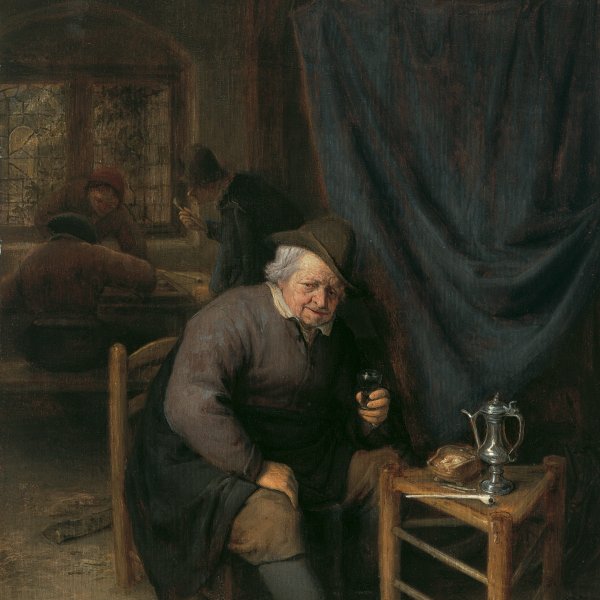Adriaen van Ostade
Haarlem, 1610 -1685
Adriaen van Ostade was baptised in Haarlem in 1610. He was the son of Jan Hendricx. van Eindhoven, a linen weaver, and the older brother of the painter Isack van Ostade. Little is known of his early training but Houbraken states that he studied with Frans Hals, in whose studio he coincided with the painter Adriaen Brouwer. Van Ostade’s first signed work, Peasants playing Cards (Hermitage, St. Petersburg), dates from 1633. In 1634 the artist registered in the painters’ guild in Haarlem. His early works depict lively scenes of peasants in rowdy taverns, compositions that reveal the influence of Brouwer and of Rembrandt’s use of chiaroscuro.
In 1636 Van Ostade married Machtelje Pietersdr. in Haarlem, who died six years later. At this period the artist’s work became increasingly organised with regard to composition and pictorial depth and in the 1640s his interiors acquired greater atmosphere and sense of space. Around the mid-century Van Ostade’s style evolved towards a more idealised one and his paintings featured tranquil, socially respectable figures, possibly responding to his own, more elevated social status and to a new type of clientele.
In 1667, having converted to Catholicism, Van Ostade remarried, this time to Anna Ingels, a wealthy Catholic from Amsterdam. In 1647 and 1661 he was president of the painters’ guild and in 1662 was appointed dean. Van Ostade enjoyed an elevated reputation as a painter and a comfortable economic situation for the remainder of his life.
The paintings of his last period depict respectable country people in comfortable surroundings. He also painted a number of portraits, of both individuals and groups, and elaborate, luxurious still lifes, in addition to his considerable output as a printmaker.
Van Ostade collaborated with Pieter Saenredam on a number of paintings and with Jacob van Ruisdael on his landscapes. His most important pupil was his brother Isack van Ostade, although he also had a number of followers including Thomas Wijck, Cornelius Bega, Michiel van Musscher, Jan Steen, Jan de Groot and Cornelius Dusart.
In 1636 Van Ostade married Machtelje Pietersdr. in Haarlem, who died six years later. At this period the artist’s work became increasingly organised with regard to composition and pictorial depth and in the 1640s his interiors acquired greater atmosphere and sense of space. Around the mid-century Van Ostade’s style evolved towards a more idealised one and his paintings featured tranquil, socially respectable figures, possibly responding to his own, more elevated social status and to a new type of clientele.
In 1667, having converted to Catholicism, Van Ostade remarried, this time to Anna Ingels, a wealthy Catholic from Amsterdam. In 1647 and 1661 he was president of the painters’ guild and in 1662 was appointed dean. Van Ostade enjoyed an elevated reputation as a painter and a comfortable economic situation for the remainder of his life.
The paintings of his last period depict respectable country people in comfortable surroundings. He also painted a number of portraits, of both individuals and groups, and elaborate, luxurious still lifes, in addition to his considerable output as a printmaker.
Van Ostade collaborated with Pieter Saenredam on a number of paintings and with Jacob van Ruisdael on his landscapes. His most important pupil was his brother Isack van Ostade, although he also had a number of followers including Thomas Wijck, Cornelius Bega, Michiel van Musscher, Jan Steen, Jan de Groot and Cornelius Dusart.






